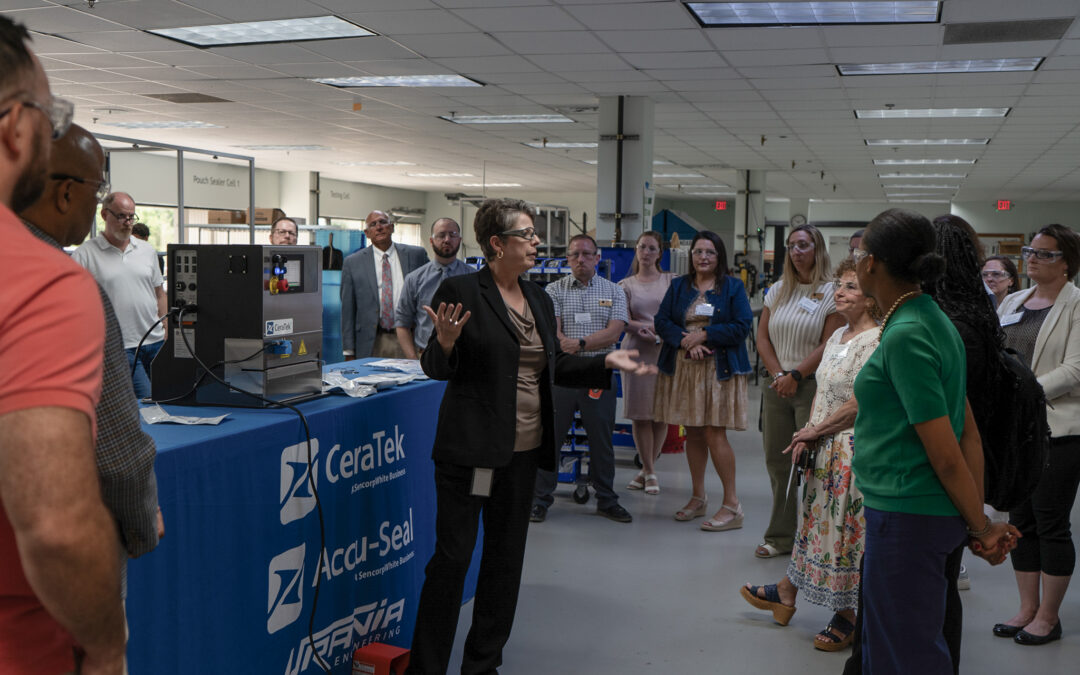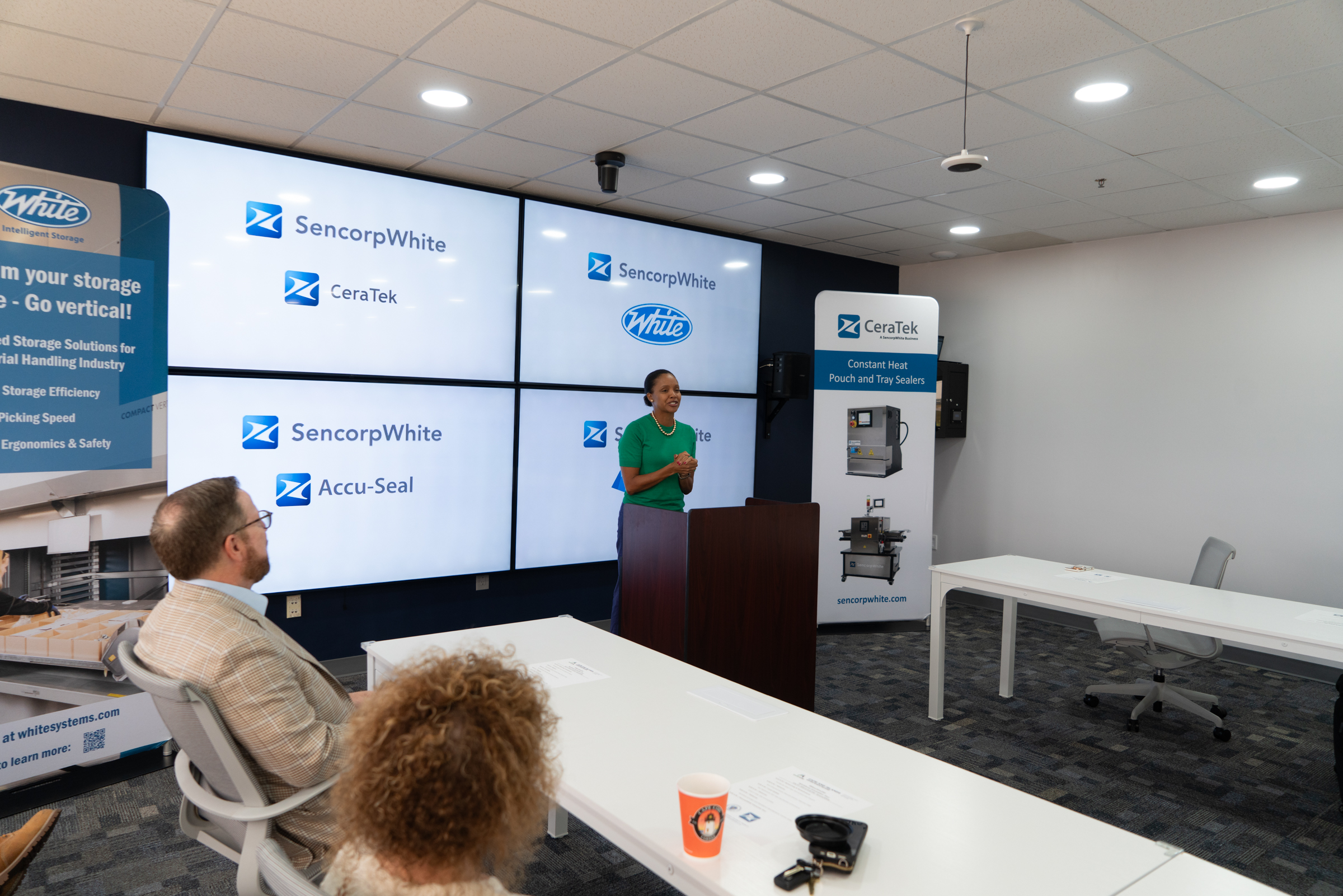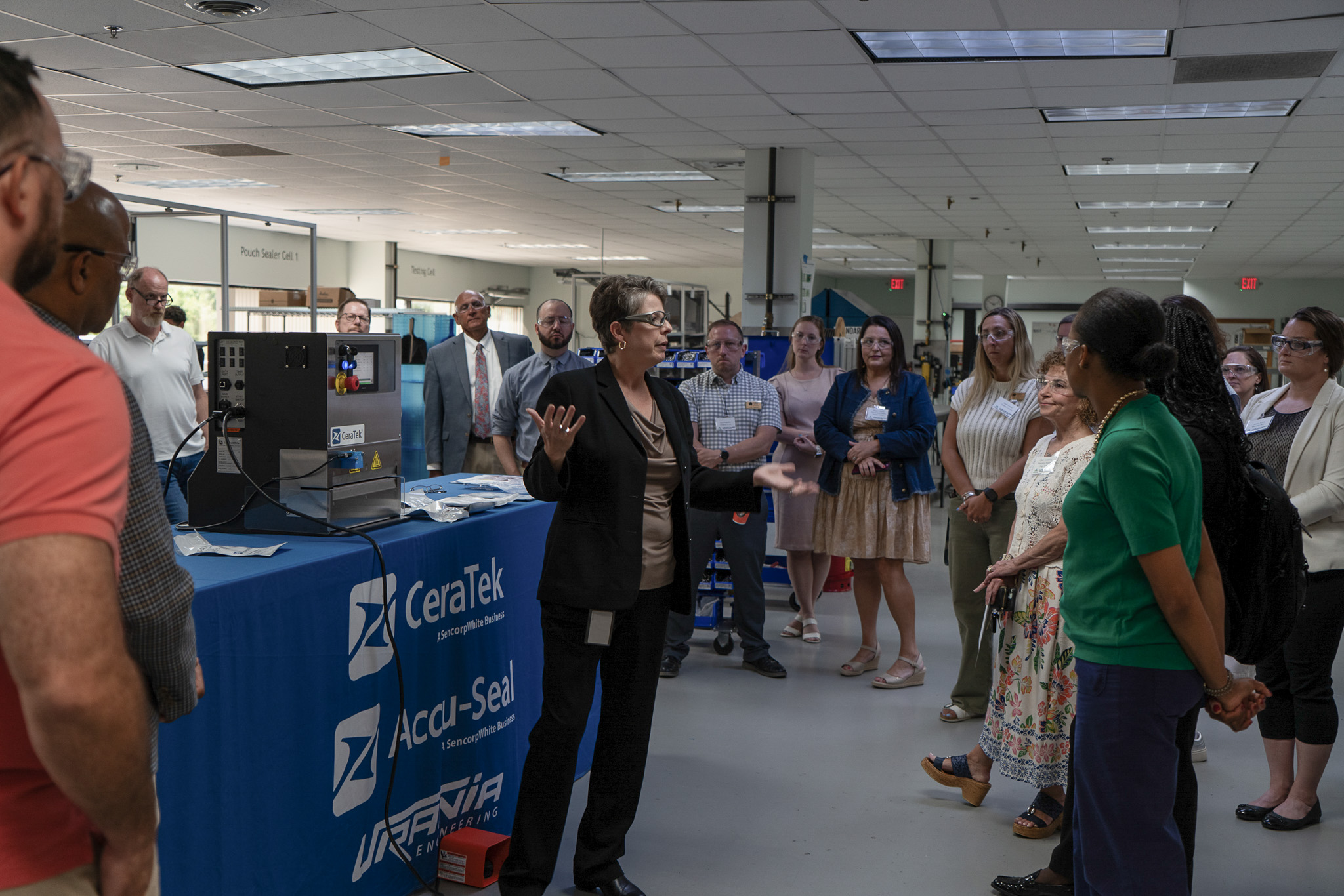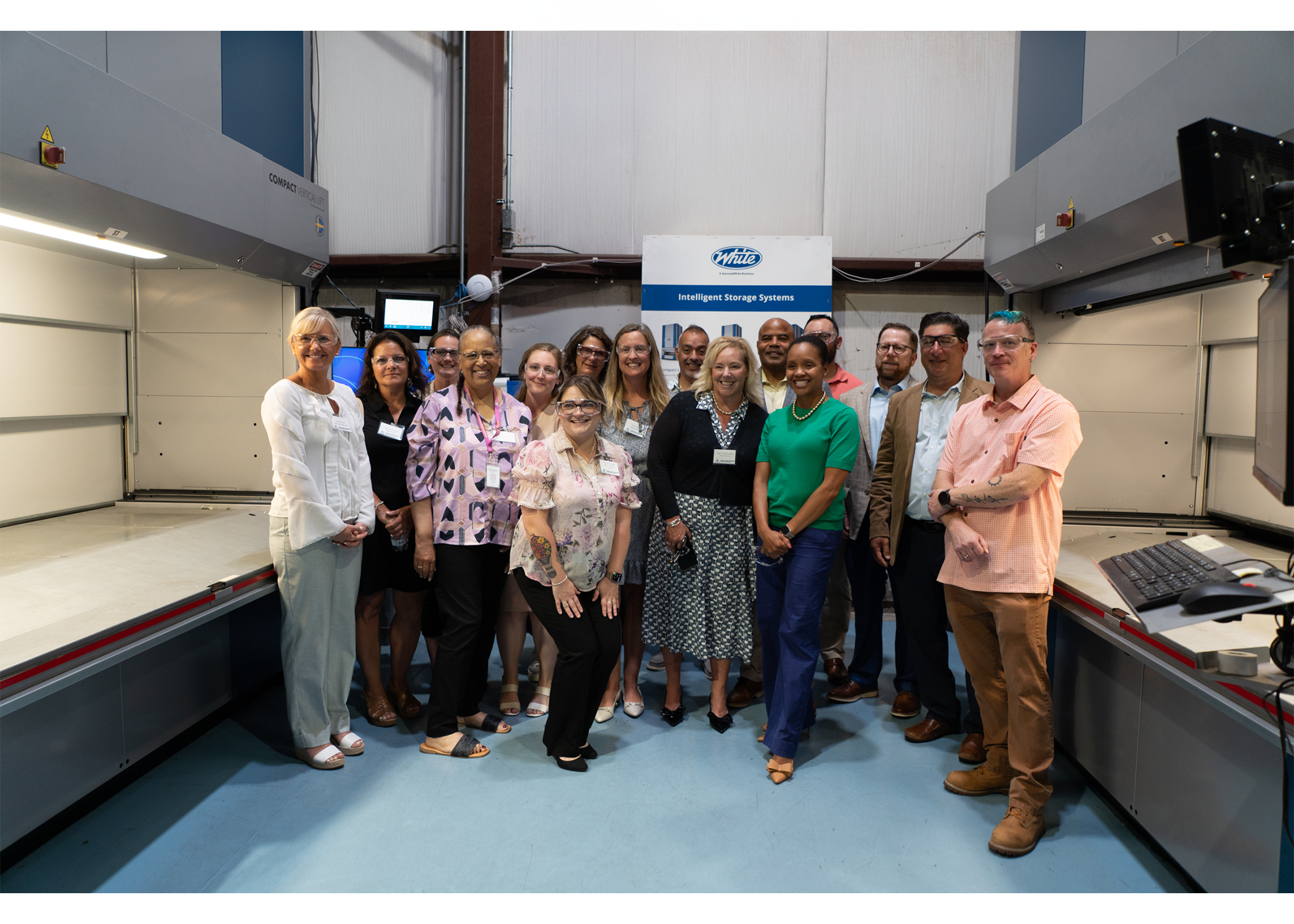
Jul 10, 2025 | Blog
On July 8th, CeraTek was proud to host the MassHire250 Workforce Innovation Tour at our headquarters in Hyannis, Massachusetts. The event, led by Massachusetts Secretary of Labor and Workforce Development Lauren Jones, brought together state and local leaders to spotlight workforce development, advanced manufacturing, and regional job creation.
As part of the statewide MassHire250 initiative, the tour highlighted the importance of public-private collaboration in building a future-ready economy. Secretary Jones was joined by Kara O’Donnell-Galvin, Executive Director of the MassHire Cape & Islands Workforce Board, and Paul Niedzwiecki, CEO of the Cape Cod Chamber of Commerce, for opening remarks and a discussion on training pipelines, employer partnerships, and sustainable growth across the Cape.
Our CEO, Corey Calla, also participated in the program, offering insights on White Intelligent Storage ongoing commitment to growing skilled jobs and supporting innovation in manufacturing.
After the presentations, Lynne Barton guided attendees through a live demo in our sealer assembly area, where guests got a firsthand look at the engineering and precision behind the CeraTek medical pouch sealer. Following that, Corey Calla led a tour of the White Intelligent Storage production area, showcasing the capabilities of our Weland Vertical Lift Module (VLM) and how automation is transforming modern warehousing.
These demonstrations gave guests a closer look at the advanced systems we build — and the talented teams behind them
Supporting the Future of Manufacturing on Cape Cod
At CeraTek, we believe that innovation doesn’t stop at the machine — it extends to the people who build, maintain, and support that technology. That’s why we were excited to share not just what we manufacture, but how we’re helping grow the next generation of skilled workers in the region.
Cape Cod faces real challenges when it comes to workforce development — including access to training, housing affordability, and retaining young talent. Events like the MassHire250 tour are essential in helping employers, educators, and public leaders align around shared solutions.
Whether it’s through on-the-job training, internal advancement, or partnerships with local schools and workforce boards, we’re committed to creating career opportunities that last, right here at home.
We’d like to thank Secretary Jones, the MassHire Cape & Islands Workforce Board, and all our guests for spending the morning with us. We’re honored to be part of a growing movement to strengthen the workforce and drive innovation across Massachusetts.
Interested in joining our team? Learn more about careers at CeraTek
Want to collaborate on workforce initiatives?
Nov 15, 2023 | Blog, CeraTek
 In modern healthcare, precision, and sterility are non-negotiable.
In modern healthcare, precision, and sterility are non-negotiable.
Among the many technologies that quietly play important roles in maintaining these standards, medical heat sealing devices stand out because of their precise combination of heat and pressure to achieve the essential task of melting and fusing the edges of plastic materials.
Let’s explore the intricate workings of medical heat sealing devices, shedding light on how they create secure and sterile seals for medical applications.
The Role of Heat
At the heart of the medical heat-sealing process lies the element of heat.
Medical heat sealing devices are equipped with heating elements that can be precisely controlled to reach specific temperatures.
The choice of temperature is carefully calibrated based on the type of thermoplastic material being sealed. When the heated element or bar comes into contact with the plastic material, it initiates a fundamental transformation.
Melting the Adhesive
As heat is applied, it gradually raises the temperature of the plastic material in the sealing area. It’s important to note that different plastics have varying melting points, so the device’s temperature settings are adjusted accordingly.
Once the plastic reaches its specific melting point, it undergoes a crucial transformation—it becomes pliable and starts to liquefy.
The Role of Pressure
In combination with heat, pressure plays a critical role in the sealing process, making it a dynamic duo in the creation of secure seals.
Medical heat sealing devices are designed to exert controlled pressure on the melted plastic, and this pressure serves several an essential purpose including:
- Bonding the edges

- Preventing Air Entrapment
- Enhancing Bond Strength
Bonding the Edges
The pressure applied by the sealing device plays a pivotal role in bringing the melted plastic edges together. This intimate contact between the plastic surfaces facilitates the fusion process, creating a strong and seamless connection.
Preventing Air Entrapment
Beyond bonding, pressure also serves to expel any trapped air or gases from the sealing area. The presence of air pockets can weaken the seal, making it less secure. The pressure ensures that the seal is free from any imperfections.
Enhancing Bond Strength
The combination of heat and pressure doesn’t just superficially bond the plastic edges; it promotes molecular intermingling between the melted plastic surfaces. This intermingling creates a bond that is robust and durable.
As the plastic cools and solidifies, the bond becomes permanent and resilient.
The Final Touch: Cooling and Solidification
After the heat and pressure have performed their intricate dance, the sealing device transitions to a crucial phase: cooling and solidification. While maintaining pressure, the device allows the plastic to cool.
This phase is as critical as the previous steps because it ensures that the plastic remains in its fused state, creating a permanent and secure seal.
In essence, medical heat-sealing devices are masters of precision and sterility. They harness the power of heat and pressure to transform thermoplastic materials, beginning by raising the plastic’s temperature to its melting point, rendering it pliable.
Controlled pressure then steps in to bond the melted edges intimately, expel any unwanted air, and promote molecular intermingling.
As the plastic cools and solidifies, the result is a secure, sterile, and reliable seal—truly the essence of medical heat sealing.
These sealed enclosures are a cornerstone of healthcare, ensuring that medical supplies, instruments, and devices meet the exacting standards of safety and sterility in a variety of critical applications in the medical field. For more information about our heat sealing machines, contact us.

Nov 15, 2023 | Blog
In modern healthcare, precision, and sterility are non-negotiable.
Among the many technologies that quietly play important roles in maintaining these standards, medical heat sealing devices stand out because of their precise combination of heat and pressure to achieve the essential task of melting and fusing the edges of plastic materials.
Let’s explore the intricate workings of medical heat sealing devices, shedding light on how they create secure and sterile seals for medical applications.
The Role of Heat
At the heart of the medical heat-sealing process lies the element of heat.
Medical heat sealing devices are equipped with heating elements that can be precisely controlled to reach specific temperatures.
The choice of temperature is carefully calibrated based on the type of thermoplastic material being sealed. When the heated element or bar comes into contact with the plastic material, it initiates a fundamental transformation.
Melting the Adhesive
As heat is applied, it gradually raises the temperature of the plastic material in the sealing area. It’s important to note that different plastics have varying melting points, so the device’s temperature settings are adjusted accordingly.
Once the plastic reaches its specific melting point, it undergoes a crucial transformation—it becomes pliable and starts to liquefy.
The Role of Pressure
In combination with heat, pressure plays a critical role in the sealing process, making it a dynamic duo in the creation of secure seals.
Medical heat sealing devices are designed to exert controlled pressure on the melted plastic, and this pressure serves several an essential purpose including:
- Bonding the edges

- Preventing Air Entrapment
- Enhancing Bond Strength
Bonding the Edges
The pressure applied by the sealing device plays a pivotal role in bringing the melted plastic edges together. This intimate contact between the plastic surfaces facilitates the fusion process, creating a strong and seamless connection.
Preventing Air Entrapment
Beyond bonding, pressure also serves to expel any trapped air or gases from the sealing area. The presence of air pockets can weaken the seal, making it less secure. The pressure ensures that the seal is free from any imperfections.
Enhancing Bond Strength
The combination of heat and pressure doesn’t just superficially bond the plastic edges; it promotes molecular intermingling between the melted plastic surfaces. This intermingling creates a bond that is robust and durable.
As the plastic cools and solidifies, the bond becomes permanent and resilient.
The Final Touch: Cooling and Solidification
After the heat and pressure have performed their intricate dance, the sealing device transitions to a crucial phase: cooling and solidification. While maintaining pressure, the device allows the plastic to cool.
This phase is as critical as the previous steps because it ensures that the plastic remains in its fused state, creating a permanent and secure seal.
In essence, medical heat-sealing devices are masters of precision and sterility. They harness the power of heat and pressure to transform thermoplastic materials, beginning by raising the plastic’s temperature to its melting point, rendering it pliable.
Controlled pressure then steps in to bond the melted edges intimately, expel any unwanted air, and promote molecular intermingling.
As the plastic cools and solidifies, the result is a secure, sterile, and reliable seal—truly the essence of medical heat sealing.
These sealed enclosures are a cornerstone of healthcare, ensuring that medical supplies, instruments, and devices meet the exacting standards of safety and sterility in a variety of critical applications in the medical field. For more information about our heat sealing machines, contact us.
Nov 1, 2023 | Blog, CeraTek
In the evolving field of healthcare, innovation isn’t limited to medical devices alone. Packaging, particularly medical device pouches, is undergoing a technological revolution.
These pouches are no longer just protective coverings but are now integrating technologies to enhance patient safety, streamline inventory management, and improve overall healthcare processes.
Let’s explore the exciting world of emerging trends in medical device pouch technology.

Standard Packaging for Medical Devices
Standard medical device pouches, also known as sterilization pouches, are specialized packaging materials designed to maintain the sterility of medical devices.
They are made from medical-grade materials, heat-sealable, transparent, and often feature indicator strips to confirm sterilization.
These pouches come in various sizes, are easy to open, and may include tamper-evident features. They adhere to industry standards and regulations, ensuring the safe and aseptic storage of medical devices until they are ready for use.
Medical device packaging plays a crucial role in healthcare by:
- Maintaining sterility, protecting against environmental factors and physical damage
- Ensuring product integrity
- Facilitating sterilization
- Aiding in identification and traceability
- Providing tamper-evident features
- Promoting regulatory compliance
- Enabling efficient storage and transportation of medical devices.
Most importantly, medical device pouches contribute to patient safety and ensure that devices are in optimal condition when needed for clinical use.
“Smart Packaging” for Medical Devices
Smart packaging, often referred to as “intelligent packaging,” is gaining ground in the medical device industry. These pouches are equipped with sensors and data-processing capabilities, allowing them to monitor various aspects of the enclosed device.
Smart pouches can track the condition and status of the medical device inside. For example, they can monitor temperature, humidity, and sterilization levels to ensure the device remains safe for use.
By providing data on the device’s status, smart pouches assist in inventory management, helping healthcare facilities keep track of their supplies more efficiently.
RFID Tracking and Identification
Radio-frequency identification (RFID) technology has revolutionized inventory tracking and device management in the healthcare sector. RFID tags can be integrated into medical device pouches.
RFID-enabled pouches provide real-time visibility into inventory levels. This helps healthcare facilities optimize their stock, reducing waste and ensuring timely resupply.
Every tagged pouch can be tracked throughout its lifecycle. This traceability is particularly crucial for high-value or critical medical devices.
RFID technology minimizes manual data entry errors, ensuring the right device is used for the right patient.
Data Monitoring and Connectivity
Connectivity is a buzzword in modern healthcare, and medical device pouches are joining the IoT (Internet of Things) revolution. These pouches can incorporate data monitoring capabilities and connect to hospital systems through wireless networks.
Medical device pouches can transmit data about the device’s condition directly to healthcare information systems. This enables immediate decision-making and intervention when necessary.
Data monitoring can contribute to patient safety by ensuring that medical devices are in optimal condition before use, reducing the risk of complications.
Transforming Patient Safety
Ultimately, emerging trends in medical device pouch technology are transforming the way healthcare facilities manage their supplies and ensure patient safety.
Standard packaging, smart packaging, RFID tracking, and data monitoring are visible in a world of greater transparency, efficiency, and reliability in the healthcare sector.
As technology continues to advance, we can expect further integration of these innovations into medical device pouches, improving patient outcomes and the overall healthcare experience.
The future of medical device packaging is intelligent, connected, and committed to enhancing the quality of care delivered to patients worldwide.
Contact our team to learn more and choose a medical device packaging system that works best for your business.
Oct 15, 2023 | Blog, CeraTek
 Packaging is not just a protective layer; it’s a critical component that can directly impact patient safety and product integrity.
Packaging is not just a protective layer; it’s a critical component that can directly impact patient safety and product integrity.
A secure and reliable seal prevents contamination, maintains sterility, and preserves the efficacy of medical devices.
Seal strength testing is a crucial quality control step in the medical device packaging field, ensuring that seals meet the high standards necessary for the healthcare industry.
What is the purpose of testing the seal?
The primary purpose of seal strength testing is to verify that the seals on medical device packaging are strong enough to withstand various stresses and conditions during transportation, storage, and handling, without compromising the sterility and quality of the enclosed medical devices.
Seal Strength Testing Methods
Several methods are used to test the strength of seals in medical device packaging, including:
- Peel testing
- Burst testing
- Tensile testing
Peel Testing
Peel testing is a widely used method in the assessment of seal strength for various types of packaging, especially medical device packaging.
This method involves applying a controlled force to separate two sealed surfaces, typically at a 90-degree angle, simulating the process of opening the package.
Peel testing provides valuable insights into the integrity of the seal. It assesses whether the seal is uniform and consistent along its length, as an uneven seal can lead t

o weak points that compromise package integrity.
A well-sealed package should require a consistent and adequate force to open, ensuring the contents remain protected until intentionally accessed.
Beyond assessing the seal’s strength, peel testing also helps evaluate its resistance to tampering or unauthorized access. Peel testing helps verify that such tamper-evident features function as intended.
Burst Testing
This method assesses the package’s ability to withstand internal pressure changes without rupturing.
During burst testing, the sealed package is subjected to an increase in internal pressure. This pressure is gradually applied until the package fails, i.e., the seal ruptures. The pressure at which this failure occurs is recorded.
Burst testing is a critical quality control measure for packages that must maintain their integrity under specific conditions.
Tensile Testing
Tensile testing evaluates the strength of the sealed edges of a package and measures the force required to pull them apart. This method is essential for packages that require a strong seal to prevent accidental tearing or opening.
Tensile testing provides a quantitative measure of the seal’s strength along the sealed edges. This is particularly important for packages that need to withstand rough handling during shipping and distribution.
Packages holding fragile devices that need seals that are resistant to tearing or damage during transit. Tensile testing helps ensure the packaging can withstand these challenges.
The Significance of Seal Strength
Patient Safety
The primary goal of medical device packaging is to safeguard patients from contamination and infection.
A weak seal can lead to breaches in sterility, potentially causing harm to patients who rely on these devices for their health and well-being.
Preventing Contamination
Medical devices often come into contact with sensitive areas of the body or are used in sterile environments, such as surgical procedures.
A weak or compromised seal on the packaging of these devices could lead to contamination, which may result in infections or complications for patients. Ensuring the integrity of seals through testing helps prevent such issues and protects patient health.
Regulatory Compliance
Medical device packaging must adhere to strict regulations and standards set in the medical field. Seal strength testing is often a mandatory requirement to demonstrate compliance with these standards.
Compliance with these regulations helps ensure that only safe and effective medical devices are available to healthcare providers and patients.
Seal strength testing is the key patient safety and product integrity in the medical device packaging field.
It ensures that medical devices are delivered to healthcare providers and patients in a safe and reliable condition.
By doing so, they not only protect patients but also their own reputation and bottom line, contributing to the overall betterment of healthcare worldwide. Contact our team today to learn more!
Oct 1, 2023 | Blog, CeraTek
 One often overlooked yet crucial aspect of medical device and packaging production is heat sealing. This unassuming process plays a vital role in ensuring the integrity of medical equipment and supplies, contributing significantly to patient well-being and the effectiveness of healthcare.
One often overlooked yet crucial aspect of medical device and packaging production is heat sealing. This unassuming process plays a vital role in ensuring the integrity of medical equipment and supplies, contributing significantly to patient well-being and the effectiveness of healthcare.
Let’s explore the importance of heat sealing in the medical field and how it impacts various aspects of healthcare.
What is Heat Sealing?
Heat sealing, also known as heat welding or thermal sealing, is a process that utilizes heat to create a hermetic seal on two or more thermoplastic materials. These materials can include various plastics, such as polyethylene, polypropylene, and PVC, as well as laminates and films.
It involves two main components: heat and pressure. The process involves the application of heat and pressure to the materials, causing them to melt and fuse together. Once the heat source is removed and the materials cool, a strong and secure seal is formed.
By applying heat to the edges or seams of two materials and exerting pressure, the materials bond together, creating an airtight and watertight seal.
This technique is widely used in the medical field for packaging, manufacturing, and assembly of various medical devices and equipment.
The Importance of Heat Sealing in the Medical Field
Sterility Assurance
One of the primary reasons for the widespread use of heat sealing in the medical field is its ability to maintain sterility.
Medical devices, surgical instruments, and pharmaceutical products must remain free from contaminants to ensure patient safety.
Heat sealing provides a reliable method to seal packaging materials, such as:
- Sterilization pouches
- Blister packs
- IV bags
And effectively prevent the ingress of microorganisms and maintain sterility until the moment of use.
Extended Shelf Life
Many medical products, such as diagnostic test kits, sutures, and catheters, have a limited shelf life.
Heat sealing ensures that these items remain sealed and protected from environmental factors like moisture, oxygen, and light that can degrade their quality.
This extends the shelf life of medical products, reducing waste and saving costs in the long run.

Tamper-Evident Packaging
In the medical field, tamper-evident packaging is crucial to detect any unauthorized access or tampering with medical supplies.
Heat-sealed packaging can include tamper-evident features, such as visible seals that break upon opening.
This provides a clear indication to healthcare providers and patients that the product may have been compromised and should not be used.
Packaging Integrity
For medical equipment like catheters, stents, and surgical drapes, the integrity of the packaging is paramount.
Heat sealing ensures that these products are securely packaged, protecting them from physical damage during transportation and storage.
This reduces the risk of contamination and ensures that medical professionals receive undamaged, reliable products.
Customization and Efficiency
Heat sealing technology allows for precise customization of packaging to accommodate various medical devices and shapes.
This versatility and efficiency in production are essential for medical manufacturers who need to adapt to a wide range of product sizes and designs.
Heat sealing machines can be adjusted to meet specific requirements, ensuring a seamless and cost-effective manufacturing process.
Heat sealing might not always be in the spotlight of the medical field, but its significance cannot be understated.
With the continuous advancement of medical technology, the importance of heat sealing in the healthcare sector will only continue to grow.
As medical professionals and manufacturers strive to provide the best possible care and products, the reliability and precision of heat sealing technology will remain an indispensable tool.
Contact one of our team experts to learn more about heat sealing and how it can be a vital addition to your business.






 In modern healthcare, precision, and sterility are non-negotiable.
In modern healthcare, precision, and sterility are non-negotiable.







 Packaging is not just a protective layer; it’s a critical component that can directly impact patient safety and product integrity.
Packaging is not just a protective layer; it’s a critical component that can directly impact patient safety and product integrity.
 One often overlooked yet crucial aspect of medical device and packaging production is heat sealing. This unassuming process plays a vital role in ensuring the integrity of medical equipment and supplies, contributing significantly to patient well-being and the effectiveness of healthcare.
One often overlooked yet crucial aspect of medical device and packaging production is heat sealing. This unassuming process plays a vital role in ensuring the integrity of medical equipment and supplies, contributing significantly to patient well-being and the effectiveness of healthcare.